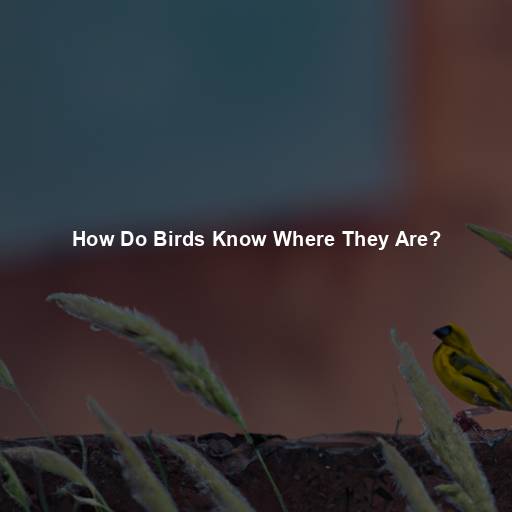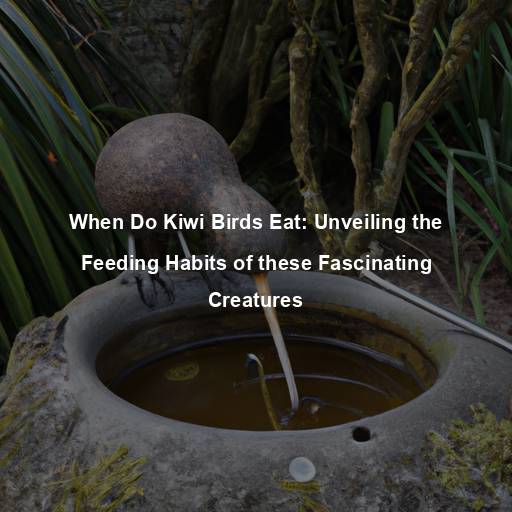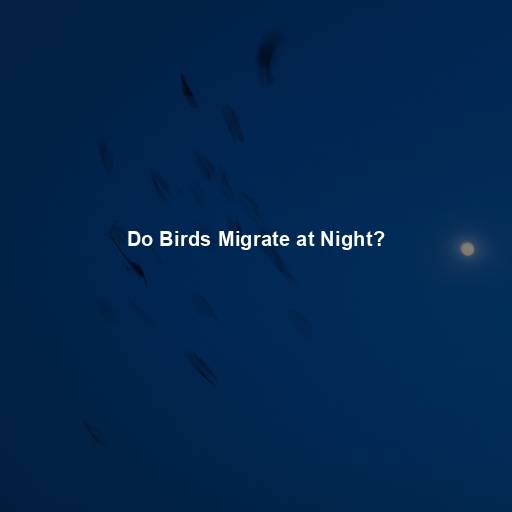How Do Birds Know Where They Are?
Last Updated on November 15, 2023 by Evan
Contents [hide]
- 1 Exploring the Fascinating Navigation Skills of Birds
- 1.1 The Inner GPS: Magnetic Sensitivity
- 1.2 Celestial Navigation: Guided by the Stars
- 1.3 Landmarks and Visual Landscapes: Mapping the Terrain
- 1.4 Sun Compass: Using the Sun as a Guide
- 1.5 Environmental Cues: Weather Patterns and Atmospheric Conditions
- 1.6 Innate and Learned Behaviors: Nature versus Nurture
- 1.7 Ongoing Research: Unraveling the Mysteries
- 1.8 Conservation Implications: Protecting Bird Habitats
- 1.9 The Phenomenon of Bird Migration
- 1.10 Instinctual Guidance: Innate Navigation Abilities
- 1.11 Magnetic Fields: A Key Navigational Tool
- 1.12 Celestial Signposts: Guiding the Way
- 1.13 Visual Landmarks: Mapping the Terrain
- 1.14 Environmental Factors: Weather and Food Availability
- 1.15 Time and Navigation: Circadian Rhythms
- 1.16 Human Influence: Challenges and Conservation Efforts
- 1.17 The Endless Wonder of Bird Navigation
- 1.18 Tracking Technologies: Insights into Bird Migration
- 1.19 Genetic Studies: Unlocking the Secrets
- 1.20 Behavioral Experiments: Testing Hypotheses
- 1.21 Cognitive Mapping: Mental Representations
- 1.22 Evolutionary Perspectives: Adaptive Advantages
- 1.23 Cultural Transmission: Learning from Others
- 1.24 Navigation Challenges: Complex Environments
- 1.25 The Wonder Continues: A Never-Ending Exploration
- 2 FAQs
Birds have always captivated the human imagination with their mesmerizing beauty and enchanting melodies. With their vibrant colors and charming songs, they possess an undeniable allure that sets them apart from all other creatures. Yet, one of the most perplexing mysteries surrounding these winged wonders lies in their seemingly uncanny ability to navigate vast expanses of land and sky. How do these feathered beings manage to pinpoint their location with such astonishing accuracy?
The Inner GPS: Magnetic Sensitivity
The fascinating phenomenon of birds effortlessly navigating vast distances has long puzzled experts. The enigmatic ability can be attributed to a remarkable internal compass, finely tuned to the Earth’s magnetic field. Ingeniously, birds possess a mysterious organ known as the “magnetoreception system,” whispering secrets of their magnetic sensitivity. Intriguingly, recent scientific studies have shed light on a pivotal element in this captivating puzzle – the existence of a protein named cryptochrome, nestled within the avian eyes and shared among other animal species as well.
It’s fascinating how birds possess this hidden talent for using celestial cues to chart their course in the vast sky. They gracefully utilize the sun’s position during the day, and when darkness envelops the world, they turn their gaze towards the moon and stars to maintain their steady flight. Even in the face of cloudy or overcast skies, these avian navigators expertly decode the intricate patterns of celestial bodies, ensuring they stay on track. This remarkable celestial navigation skill becomes a crucial tool for birds embarking on arduous migratory journeys, where the comfort of recognizable landmarks might be nothing more than a distant memory.
Landmarks and Visual Landscapes: Mapping the Terrain
In addition to their magnetic sensitivity and celestial navigation, birds also rely on visual landmarks and familiar landscapes to navigate. They create mental maps of their territories, marking significant landmarks such as mountains, rivers, and coastlines. By recognizing these visual cues, birds can accurately navigate through their environment, even in the absence of clear celestial or magnetic references.
Sun Compass: Using the Sun as a Guide
In the intricate world of avian navigation, it’s not just maps and GPS that birds rely on to find their way. Believe it or not, our feathered friends harness the power of the sun as their trusty compass. By skillfully observing the sun’s majestic position in the sky and its enigmatic dance, birds are able to chart a course and stay on track, even in the absence of familiar cues. This celestial guidance, coupled with their innate instincts and a keen eye for visual landmarks, allows birds to conquer perplexing journeys and arrive at their desired havens unscathed.
Environmental Cues: Weather Patterns and Atmospheric Conditions
As the world awakens to a symphony of nature’s marvels, one cannot help but be captivated by the extraordinary instincts of our feathered friends. Birds, it seems, possess an otherworldly connection to the very fabric of our environment. Through a mysterious dance with celestial and magnetic forces, they navigate the sky with grace and precision. Yet, their talents extend beyond these cosmic realms.
Innate and Learned Behaviors: Nature versus Nurture
Birds possess an awe-inspiring blend of innate talents and acquired prowess when it comes to navigating our vast skies. The enigmatic ability to tap into Earth’s magnetic forces originates from their genes, while other astute techniques are gleaned through firsthand experience and keen observation. Like diligent apprentices, fledglings meticulously absorb the guidance of their parents and fellow flock mates, meticulously crafting their aptitude with each flight. This harmonious interplay between nature’s secrets and the nurturing embrace of avian society equips birds to conquer the skies, effortlessly soaring through diverse landscapes.
Ongoing Research: Unraveling the Mysteries
After years of tireless investigation, the captivating enigma of avian navigation lingers, perplexing the scientific community. A symphony of unanswered questions orchestrates this colorful tapestry of research, as diligent scientists strive to unravel the intricacies underlying the spellbinding flight of birds. Armed with cutting-edge technologies like tracking devices and the omnipotent GPS, they embark on a quest to decipher the cryptic flight paths and mesmerizing behaviors of these migratory creatures. With each new discovery, the veil of ambiguity lifts, painting a vivid canvas of understanding and deepening our connection with the wondrous ways birds navigate the immense expanse of our planet.
Conservation Implications: Protecting Bird Habitats
The intricate art of bird navigation is a captivating realm of scientific exploration that reaches far beyond its abstract allure. This enigmatic process unfurls with perplexing beauty, encompassing a tapestry of avian journeys intricately woven with conservation implications at their core. Within this intricate puzzle lies the fragile dependence on hospitable habitats nestled along intricate flight paths. As the enigma unravels, the decoding of bird navigation illuminates invaluable insights into pivotal stopover spots, nesting havens, and migratory gateways yearning for preservation and safeguarding.
In conclusion, birds possess an extraordinary sense of direction, allowing them to navigate with precision across vast distances. Their magnetic sensitivity, celestial navigation, visual landmarks, sun compass, and environmental cues all play a role in their remarkable navigation abilities. While the mechanisms behind bird navigation are still being explored, ongoing research and conservation efforts are essential in unraveling the mysteries and ensuring the preservation of these incredible creatures. So, the next time you marvel at a bird soaring through the sky, remember that its journey is guided by a complex combination of innate skills and learned behaviors that make it a true master of navigation.
The Phenomenon of Bird Migration
The mesmerizing spectacle of bird migration is a fascinating sight to behold, as these winged wonders embark on an awe-inspiring journey from one locale to another. The mystifying reasons behind this seasonal migration encompass an intricate web of motivations, encompassing the quest for sustenance, the pursuit of ideal breeding environments, and the desire to seek out amiable weather patterns. These intrepid aviators traverse vast distances, spanning countless miles, pushing the boundaries of their navigational prowess to navigate the unknown.
Birds are born with innate navigation abilities that guide them during migration. These abilities are believed to be genetically programmed and passed down through generations. Young birds inherit a sense of direction and an internal compass that helps them navigate during their first migratory journey. This instinctual guidance, combined with environmental cues and learning from experienced individuals, allows birds to navigate successfully.
Birds possess a remarkable ability to navigate through perplexing landscapes, tapping into the enigmatic realm of the Earth’s magnetic field. Their uncanny knack for perceiving and deciphering microscopic fluctuations in these ethereal forces is nothing short of captivating. Scientists have pieced together a tantalizing puzzle with cryptochrome, a protein nestled within avian eyes, emerging as a central player in this magnetic dance. Armed with this supernatural compass, birds bravely traverse vast distances, defying the need for tangible landmarks or celestial signs.
Celestial Signposts: Guiding the Way
It’s mind-boggling how birds navigate the vast skies during their awe-inspiring migrations. Believe it or not, they rely on something beyond our comprehension – celestial cues! You see, the sun becomes their steadfast companion during the day, helping them stay on track with an unwavering determination. And when the night falls, they embark on a mystical journey guided by none other than the stars themselves, as if they were cosmic road signs.
Visual Landmarks: Mapping the Terrain
Birds possess an extraordinary ability to effortlessly chart their course through the vast expanse of the sky. Their minds intricately weave a complex tapestry of visual cues, imprinting vivid landmarks onto their mental maps. From shimmering rivers that flow like veins across the land, to the rugged majesty of towering mountains, these distinctive features serve as celestial signposts during their daring migrations. With their unwavering focus and uncanny spatial awareness, birds spread their wings in unfamiliar territories, harnessing the power of these visual landmarks to navigate with unwavering precision.
Environmental Factors: Weather and Food Availability
Bird migration is a fascinating phenomenon shaped by the enigmatic forces of nature. As our feathered friends take to the skies, their intricate dance with environmental factors becomes all the more palpable. From the whims of ever-changing weather patterns to the bountiful buffet of food awaiting their arrival, birds navigate a perplexing world of burstiness. They skillfully ride the winds, harnessing the power of favorable conditions to propel them further, while strategically pursuing areas teeming with sustenance to fuel their arduous journey.
Birds, those fascinating creatures who grace our skies, possess an uncanny ability to tap into the rhythms of time. It’s as if they have an inner clock that guides them through the vastness of their migrations. Known as circadian rhythm, this internal timekeeper enables birds to seamlessly adjust their behavior with the changing light. With their keen sense of timing, our avian friends expertly plan their journeys, ensuring that they make the most of daylight and secure safe havens under the moon‘s watchful gaze.
Human Influence: Challenges and Conservation Efforts
Birds, those magnificent creatures of the sky, have honed their navigation skills to near perfection over millennia. However, alas, they find themselves confronted with an array of perplexing challenges in our present-day world. The hand of humanity, with its habitat destruction, unfettered pollution, and the harrowing winds of climate change, disrupts the very essence of the cues and landmarks that birds rely upon to find their way. Even the artificial structures we erect, towering buildings and communication towers, unwittingly bewilder these avian voyagers, leading them into dangerous collisions.
The navigation skills of birds continue to captivate scientists and nature enthusiasts alike. The ability of these winged creatures to navigate across vast distances with remarkable precision is a testament to the wonders of the natural world. As ongoing research sheds light on the complex mechanisms behind bird navigation, we gain a deeper understanding of the intricate relationship between birds and their environment. By celebrating and protecting these incredible journeys, we ensure that future generations can marvel at the awe-inspiring spectacle of bird migration.
Tracking Technologies: Insights into Bird Migration
Bird navigation has been taken to new heights with the help of groundbreaking tracking technologies. The advent of satellite tracking devices and geolocators has opened up a treasure trove of information on the extraordinary journeys undertaken by migratory birds. Armed with these cutting-edge tools, scientists can now unravel the secret flight paths, hidden stopover spots, and elaborate migration patterns that these avian travelers employ. Through careful analysis of this wealth of data, researchers are gaining unprecedented insights into the perplexing navigation strategies adopted by various species of birds.
Genetic Studies: Unlocking the Secrets
Genetic studies have shed light on the genetic basis of bird navigation. Researchers have identified specific genes that play a role in the development of the magnetoreception system and other navigational abilities. By studying the genetic variations among bird populations, scientists can better understand how these genes influence navigation and migration behavior. This research opens up exciting possibilities for further unraveling the mysteries of bird navigation.
Behavioral Experiments: Testing Hypotheses
Scientists conduct behavioral experiments to test hypotheses and gain a deeper understanding of bird navigation. These experiments often involve manipulating environmental cues, such as magnetic fields or visual landmarks, to observe how birds respond. By carefully analyzing the behavior of birds in controlled settings, researchers can draw conclusions about the importance of different navigational cues and their role in guiding avian journeys.
Cognitive Mapping: Mental Representations
Birds possess a bewildering ability known as cognitive mapping, which allows them to construct intricate mental landscapes for efficient navigation. By coalescing information from sight, sound, and even smell, they create a cognitive map that serves as their trusty compass. This internal guide enables birds to effortlessly gauge their position, establish vital landmarks, and devise savvy strategies while embarking on their epic migrations. The phenomenon of cognitive mapping, with its blend of perception, recollection, and spatial prowess, lays bare the extraordinary complexity of avian cognition.
Evolutionary Perspectives: Adaptive Advantages
Throughout the vast expanse of time, the intricate dance of evolution has shaped the navigation prowess of our avian comrades. For eons, these remarkable creatures have honed their skills, granting them a delicate advantage in their diverse habitats. Through the relentless sieve of natural selection, those with superior navigational acumen rise above the rest, passing down their exceptional abilities to successive generations. Reflecting on the marvels of evolution offers a glimpse into the journey of bird navigation, unveiling the rich tapestry of its development through the ages.
Cultural Transmission: Learning from Others
In the mesmerizing world of birds, a captivating phenomenon unfolds – the exchange of knowledge through social connections. It’s as if a magical dance takes place, where the young birds eagerly watch and emulate the wise and seasoned navigators of the skies. This enchanting process allows the fledglings to acquire invaluable know-how, empowering them to embark on successful migrations. It’s a testament to the profound impact of cultural transmission, as it weaves its intricate threads in the intricate tapestry of avian navigation strategies.
Birds face numerous challenges when navigating through complex environments. Urban landscapes, with their artificial structures and high levels of light pollution, can disorient birds and disrupt their navigation. Additionally, climate change alters the timing of seasonal cues, impacting the availability of food and suitable breeding grounds. The ability of birds to adapt to these changing conditions and find alternative routes is a testament to their resilience and flexibility.
The Wonder Continues: A Never-Ending Exploration
The study of bird navigation is an ongoing endeavor that continues to inspire scientists and nature enthusiasts worldwide. Each new discovery brings us closer to understanding the intricate mechanisms behind this remarkable phenomenon. The exploration of bird navigation not only deepens our knowledge of the natural world but also underscores the importance of biodiversity conservation. By unraveling the mysteries of bird navigation, we gain a greater appreciation for the wonders of the avian world and the delicate balance of our planet’s ecosystems.
Ultimately, the field of bird navigation remains a captivating and enigmatic area of research. Scientists employ an array of methodologies, including high-tech tracking systems, genetic analysis, and behavioral experiments, in their quest to unravel the intricacies of avian navigation. Cultural transmission and the complexities of their natural environments further enhance our comprehension of this awe-inspiring phenomenon. Each new discovery both astounds and reinforces the importance of preserving these extraordinary creatures and their ecosystems.
FAQs
How do birds know where they are?
Birds, with their awe-inspiring navigational prowess, possess a fascinating array of skills that enable them to pinpoint their whereabouts with uncanny precision. At the heart of their remarkable abilities lies their unique connection with the Earth’s magnetic forces. Intriguingly, these avian wanderers boast specialized cells nestled within their eyes, tuned to the subtle whispers of the planet’s magnetic field lines. Merging these ethereal sensory inputs with the sights and sounds of the surrounding environment – whether it be the striking presence of landmarks or celestial cues – allows these winged marvels to unravel the enigma of their own location, leaving scientists and nature enthusiasts spellbound by their enigmatic dance with the Earth’s magnetic tapestry.
Birds are fascinating creatures when it comes to their navigational prowess. It turns out that not all birds are born equal in terms of their ability to find their way around. Some species have honed their skills to an impressive level, especially those long-distance migratory birds who traverse incredible distances with uncanny precision. In contrast, birds that prefer a settled lifestyle tend to rely more on their keen eyesight and their personal mental atlas of the local neighborhood.
Imagine this: birds, with their enchanting ability to traverse the vast skies, possess an awe-inspiring talent that defies our conventional understanding of navigation. They possess a mysterious sixth sense, an innate compass within their very souls, that does not tremble in the face of visual obscurity. Scientific revelations offer a glimpse into this extraordinary phenomenon, revealing that these aerial beings can perceive the subtlest fluctuations in the Earth’s magnetic field, harnessing this cryptic knowledge to guide their flight. And if fate should conspire to obscure their vision, these remarkable avian entities are not deterred; they turn to the symphony of sound and the fragrant whispers of the breeze to navigate their path through the perplexing spatial labyrinth.
The fascinating world of avian navigation has long puzzled researchers, who have unraveled a captivating blend of instinct and guidance in young birds. As fledglings spread their wings, they embark on epic journeys alongside their parents or fellow fliers, soaking up the wisdom of their experienced companions. Patiently, they absorb the secrets of recognizing landmarks, deciphering celestial cues, and grasping the enigmatic whispers of the magnetic field. Gradually, these captivating skills become woven into their very essence, enabling them to navigate the vast expanse of their surroundings with an awe-inspiring autonomy.
Can birds get lost while migrating?
Birds have an impressive navigational system, but they are not infallible. Occasionally, factors like severe weather conditions, human-made structures, or unfamiliar territories can disorient birds, causing them to lose their way temporarily. However, most birds have adaptive mechanisms to correct their course and regain their intended path. They can rely on their navigational abilities, past experiences, and even adjust their flight patterns based on environmental cues to find their way back on track.
Do birds always return to the same location during migration?
Many species of birds exhibit remarkable site fidelity, which means they tend to return to the same locations year after year, including during migration. This behavior is influenced by various factors, such as the availability of suitable habitat, food sources, and familiarity with mating grounds. However, there can be exceptions to this rule, as some birds might adjust their routes or find new locations that offer better conditions. It depends on the species, individual bird behavior, and changes in the environment over time.







